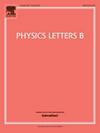广义最小超重力(GmSUGRA)中的轻中性子暗物质
IF 4.5
2区 物理与天体物理
Q1 ASTRONOMY & ASTROPHYSICS
引用次数: 0
摘要
我们研究了Higgsino质量参数μ>;0和μ<;0情况下的Higgs/Z极解。在广义最小超重力(GmSUGRA)的框架下,我们考虑了来自希格斯测量、b物理观测、LEP极限和普朗克2018遗迹密度边界的约束,以及直接探测暗物质实验的结果,包括PandaX-4T、XENON-1T、PICO-60和LUX-ZEPLIN (LZ)。我们的研究表明,LHC和LZ合作的最新实验约束在μ>;0的情况下排除了Z和H极区的轻希格sino。有趣的是,对于μ<;0的情况,非常轻的希格希诺子仍然可以符合电弱子搜索和LZ实验在Z极和H极的电流约束。因此,μ<;0的情况似乎更有希望,因此需要专门的努力,从实验合作中得出关于它们当前状态的明确结论。在这个框架中,我们的研究结果表明,与中心值aμ≡(g−2)μ/2的偏差高达2σ,与CMD和BDM报道的实验结果一致。本文章由计算机程序翻译,如有差异,请以英文原文为准。
The light neutralino dark matter in the generalized minimal supergravity (GmSUGRA)
We investigate the Higgs/Z poles solutions for the Higgsino mass parameter, and scenarios. In the framework of Generalized Minimal Supergravity (GmSUGRA), we consider the constraints from Higgs measurements, B-physics observables, LEP limits, and the Planck 2018 relic density bounds, together with the results from direct detection dark matter experiments, including PandaX-4T, XENON-1T, PICO-60, and LUX-ZEPLIN (LZ). Our study indicates that the latest experimental constraints from the LHC and LZ Collaborations exclude the light Higgsinos in the Z and H pole regions for the case. Interestingly, for the case, a very light Higgsinos can still be consistent with the current constraints from the electroweakino searches and LZ experiment in the and poles. Consequently, the case appears more promising and thus requires the dedicated efforts to make definitive conclusions about their current status from the experimental Collaborations. In this framework, our findings indicate a deviation of up to from the central value of , resonating with the experimental results reported by CMD and BDM.
求助全文
通过发布文献求助,成功后即可免费获取论文全文。
去求助
来源期刊

Physics Letters B
物理-物理:综合
CiteScore
9.10
自引率
6.80%
发文量
647
审稿时长
3 months
期刊介绍:
Physics Letters B ensures the rapid publication of important new results in particle physics, nuclear physics and cosmology. Specialized editors are responsible for contributions in experimental nuclear physics, theoretical nuclear physics, experimental high-energy physics, theoretical high-energy physics, and astrophysics.
 求助内容:
求助内容: 应助结果提醒方式:
应助结果提醒方式:


